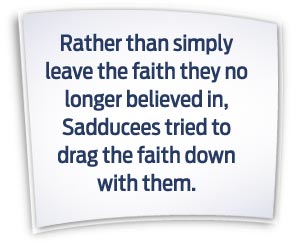
There was one group of people Jesus didn’t have much time for.
It wasn’t, of course, the down and out: the poor, the sinners, the Samaritans. All these not only found a reception with Jesus; He sought them out.
Nor was it the Pharisees. Jesus had lots of time for Pharisees. He spent hours dialoguing with Pharisees. He ate in Pharisee homes. Late at night He plumbed the depths of water and Spirit with a Pharisee. One day he would entrust a Pharisee with the gospel to the Gentiles. Jesus had more in common with Pharisees than with any other group.
True, Pharisees got bogged down in minutiae. Anxious for holiness to touch every area of life, they wound up debating whether to eat an egg laid on the Sabbath. But Jesus knew what a powerful force for the kingdom the Pharisees could be if their grace ever matched their holiness.
There were other groups in Israel. The self-supporting Essenes huddled together in study and purity, perhaps rubbing shoulders with John the Baptist and his then-disciples Andrew and John. The Zealots took their righteous fervor too far, setting back their cause more than helping it. But even a Zealot found a place in Jesus’ circle.
 No, there was only one group Jesus didn’t have much time for—a group who:
No, there was only one group Jesus didn’t have much time for—a group who:
Can we understand why Jesus so ferociously cleansed the Temple the Sadducees were desecrating? Rather than simply leave the faith they no longer believed in, Sadducees tried to drag the faith down with them. Their only remaining interest in religion was power and greed: what they could get out of it. Indeed, when the Temple was destroyed in A.D. 70, the Sadducees ceased to exist.
Jesus didn’t have much time for the Sadducees because they weren’t serious seekers. When they brought Him their sarcastic questions, “Now then, at the resurrection, whose wife will she be?” (Matt. 22:28), and “Is it right for us to pay taxes to Caesar or not?” (Luke 20:22), Jesus saw through their fakery, told them they were “badly mistaken,” and walked away.
The problem wasn’t questions. Jesus could handle questions; He welcomed questions. The problem was that their questions came without faith, without prayer, without recognition that spiritual things are spiritually discerned. “Are you not in error,” Jesus told the Sadducees, “because you do not know the Scriptures or the power of God?” (Mark 12:24).
Jesus’ final parable was for the Sadducees: a story of hardened hearts and the rejection of the prophets (the Scriptures) and ultimately the Son of God. “The stone the builders rejected,” Jesus said, “has become the cornerstone. . . . Anyone who falls on this stone will be broken to pieces; anyone on whom it falls will be crushed” (Matt. 21:42-44). Jesus used the sober imagery of stoning, with perhaps a subtle final appeal: it’s better to be broken than to be crushed.
At the end, Jesus didn’t walk away from the Sadducees. He allowed Himself to be bound by them, interrogated by them, slapped and spit on by them. Still He didn’t enter into their faithless queries, didn’t say much at all—except to name Himself as Christ and King.
This should always be the approach taken with those most opposed to Christ—people who want to be religious thought leaders apart from the Scriptures or the power of God.
______________
Andy Nash is a professor, pastor, and author of Paper God. This article was published November 17, 2011.